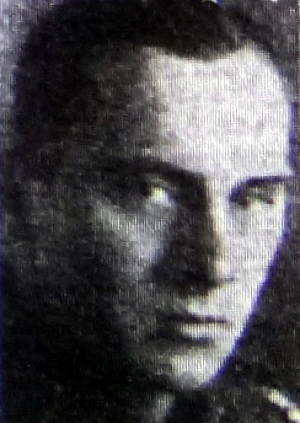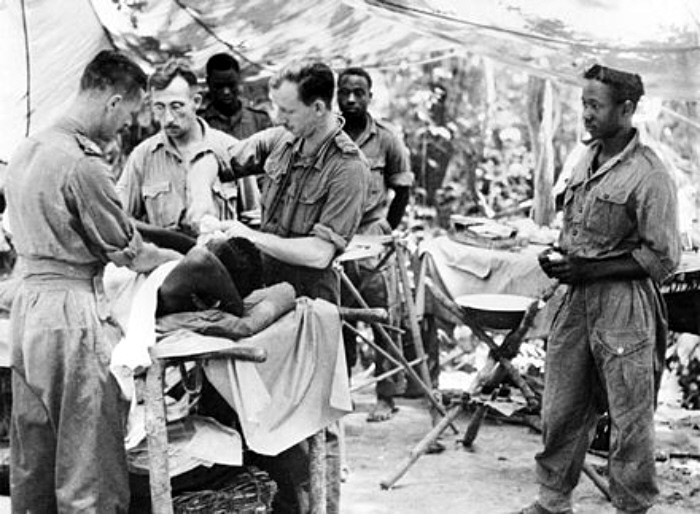
Robert Hessay was born in early 1918, the only son of Clifford Hessay and his wife Lily Speight, who were married in Ossett in 1915. Lily Hessay died in 1943, aged 53 years and Clifford Hessay remarried in 1948 to Ada L. Harrison. Clifford died in 1970, aged 82 years. Robert Hessay never married.
The 2nd Battalion, West Yorkshire Regiment was part of the 9th Indian Infantry Brigade from November 1940 to August 1945. The new brigade was assigned to the 5th Indian Infantry Division in June 1940 to January 1944. It then spent February attached to the 7th Indian Infantry Division before returning to the 5th Division. During their short time with the 7th Indian Infantry Division in February 1944, Japanese troops infiltrated through the division’s front and overran the divisional HQ.
Units of the division then took part in the subsequent Battle of the Admin Box, in which the Japanese failed to capture positions supplied by parachute drops and were forced to retreat. The West Yorkshire Regiment took a major part in the Battle of the Admin Box, their first big success against the Japanese.
The Battle of the Admin Box (sometimes referred to as the Battle of Ngakyedauk or the Battle of Sinzweya) took place on the Southern Front of the Burma Campaign from the 5th to the 23rd February 1944, in the South-East Asian Theatre of World War II.
The battle takes its name from the “administration area” of the Indian Army’s 7th Division, which became a makeshift, rectangular defensive position for Major-General Frank Messervy and his staff after their divisional headquarters was overrun by the Japanese on the 7th February 1944.
It is likely that Private Robert Hessay was wounded and then died on the 17th February 1944, and the following account of the Battle of the Admin Box gives an indication of the ferocity of the action.
“Typical Dull Japanese Ferocity”
By February 14 1944, the Japanese were fatally behind schedule. By now, Tanahashi’s men were living off unhulled rice and roots, having consumed the last of their rations. Hayana’s division was coming under increasing pressure from the 26th Division attacking from the north and Brigadier T.J. Winterton’s 123rd Brigade from Briggs’s 5th Division attacking from the west. But Hayana, with what Slim called “typical dull Japanese ferocity,” continued attacking the Admin Box instead of bypassing it and gambling on capturing supplies elsewhere. Under pressure from Hayana to overcome the Box, Tanahashi on the evening of February 14 launched an all-out attack with all three battalions of his regiment. “The night throbbed with screams, rifle fire, and shell fire,” Louis Allen wrote. But “Tanahashi could wrest no decisive victory in the face of determined resistance.” At one point, a Japanese tank destruction party tried to reach the 25th Dragoons’ tank harbor east of Ammunition Hill across open paddies. They were met by a hail of machine gun fire and were all wiped out. “The night was brilliant with star shells,” an eyewitness wrote, “and the tanks poured machine gun fire into the Japanese until their casualties forced them back.”
Retaking the Hill At All Costs:
While Tanahashi’s attacks were being repulsed, another column made its way to a height overlooking the western side of the Box, known as “C Company Hill” by the British. It was defended by a single platoon from C Company of the West Yorks. Early on the morning of February 15, the Japanese attacked, sweeping the defenders from the crest. Evans, knowing the Japanese on C Company Hill were only 300 yards from his headquarters, overlooking the hospital’s new position, and remembering the events of February 7, when another battalion from Tanahashi’s regiment attacked the main dressing station, guarded only by a section from the West Yorks and 20 walking wounded. Overwhelming the defenses, they murdered 40 British and Indian wounded in their stretchers, and forced the Indian Army medical officers to hand over their supply of quinine, morphine and other drugs. Then they murdered the medical officers, wrecked the hospital and dug in. A few patients and one medical officer escaped from the MDS, and reported the massacre. Not surprisingly in view of the Japanese atrocities, he ordered the hill retaken.
At daylight A Company of the West Yorks, led by a Major O’Hara, along with 10 Grants of 25th Dragoons’ A Squadron, counter attacked. The tanks fired high explosive 75-mm shells at the summit, keeping the Japanese pinned down, while Major O’Hara’s men moved up the slope. A Company’s first attack was met with a shower of Japanese grenades; O’Hara pulled back to let the tanks resume shelling the crest. Then A Company moved back up the ridge again, following the curtain of shells and machine gun fire. When the tanks ceased fire, the West Yorks charged the Japanese positions, clearing them from the crest, killing 17 in the process. C Company Hill was back in British hands, but the West Yorkshires took heavy casualties.1
The “Ossett Observer” had a very short obituary for Private Robert Hessay:2
“Ossett Soldier Killed – Private Robert Hessay (26), was killed in action on February 17th 1944 whilst serving in the Indian theatre of war. The only son of Mr. and the late Mrs. Clifford Hessay of Woodbine Street, Ossett, he was an old boy of Holy Trinity School and worked at Burdekin’s basket works before he joined up in 1940, since when he has served in France (being evacuated from Dunkirk), Iceland and North Africa, going to the India Command about twelve months ago.”
Private Robert Hessay died on the 17th February 1944, aged 26 years, and is buried at grave reference 5. J. 11. in the Taukkyan War Cemetery, in Burma (Myanmar). Taukkyan War Cemetery is in Taukkyan town in the township of Mingaladon, about 21 miles north of Yangon (Rangoon).
Taukkyan War Cemetery is the largest of the three war cemeteries in Burma (now Myanmar). It was begun in 1951 for the reception of graves from four battlefield cemeteries at Akyab, Mandalay, Meiktila and Sahmaw which were difficult to access and could not be maintained. The last was an original ‘Chindit’ cemetery containing many of those who died in the battle for Myitkyina. The graves have been grouped together at Taukkyan to preserve the individuality of these battlefield cemeteries.
Burials were also transferred from civil and cantonment cemeteries, and from a number of isolated jungle and roadside sites. Because of prolonged post-war unrest, considerable delay occurred before the Army Graves Service were able to complete their work, and in the meantime many such graves had disappeared. However, when the task was resumed, several hundred more graves were retrieved from scattered positions throughout the country and brought together here.
The cemetery now contains 6,374 Commonwealth burials of the Second World War, 867 of them unidentified. In the 1950s, the graves of 52 Commonwealth servicemen of the First World War were brought into the cemetery from the following cemeteries where permanent maintenance was not possible: Henzada (1); Meiktila Cantonment (8); Thayetmyo New (5); Thamakan (4); Mandalay Military (12) and Maymyo Cantonment (22).3

Above: Dressing station during the Battle of the Admin Box, February 1944.
References:
1. The Battle of Admin Box. on Warfare History Network.
2. “Ossett Observer”, Saturday, March 11th 1944.